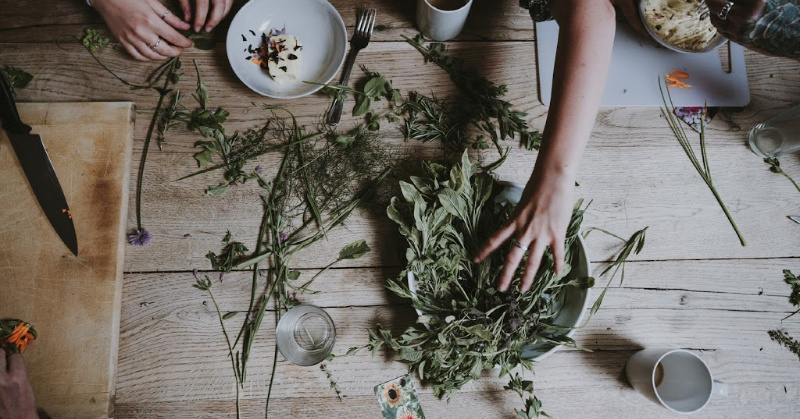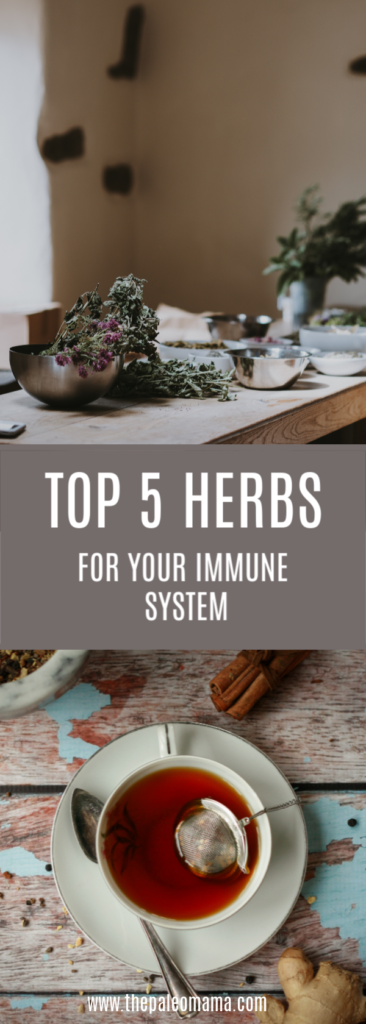
When your immune system is working well, it becomes the frontline defense against toxins, environmental threats, and other harmful microorganisms. There are key nutrients and herbs that can help to bolster defenses and keep them in peak form. Today, I’m going to share with you my top 5 herbs for staying well and give you tips for using them.
But before we dive into all the herbal goodness, let’s talk a little bit about some nutrients and foods we can incorporate into our diet to keep us healthy all year long.
If herbs interest you, I have a brand new book, The Home Apothecary: Home Crafted Recipes Using Herbs & Essential Oils, that might interest you.
3 Immune Supporting Foods:
- Probiotics. A healthy gut plays a vital role in supporting our immune systems. Our gut has a good number of healthy bacteria and also bad bacteria. When our bad bacteria outnumber the good, disease causing organisms gain a foothold on our health. Make sure that you eat a lot of “live” foods: yogurt, kefir, sauerkraut, kimchi and other lacto-fermented foods.
- Anti-fungal Foods. Overuse of antibiotics or eating a high sugar/high carbohydrate diet can lead to an unbalanced gut flora. Foods that have anti fungal properties are: coconut oil (because of the caprylic acid in it) and cruciferous vegetables such as kale, cabbage and broccoli. Brussels sprouts, cabbage, radishes and arugula contain sulfur and nitrogen compounds (called isothiocyanates) which fight overgrowth and fungal issues.
- Anti-microbial Foods. Mushrooms contain a soluble fiber known as beta-glucan. Beta-glucan enhances the action of bacteria destroying white blood sets and helps to boost immunity. Ginger is another food that has shogaols or gingerols which help to stimulate circulation and fight infection.
Top 5 Herbs for Your Immune System
1. Astragalus Root
Astragalus is a very popular Chinese herb that is primarily used as an adaptogen – which is a type of herb that helps the body to function during periods of stress, which can impact the immune system. Astragalus can be used as a daily remedy to build immune strength rather than to fight an acute immune issue.
It is most common to use the pressed roots of the astragalus roots which look like tongue depressors. I love to add these sliced roots to my bone broths, soups, stews and even marinara sauce. When you are ready to serve the food, you simply remove the astragalus and discard.
You can purchase powdered astragalus and add a teaspoon to some hot tea, smoothies, or homemade energy bars.
2. Goldenseal
Goldenseal is an American woodland, medicinal heirloom. Because of over harvesting, Goldenseal is on the United Plant Savers “At-Risk List” and should not be purchased from or gathered from the wild. The whole plant is used as medicine, but the roots or rhizomes are the most potent part.
Goldenseal contains several powerful alkaloids that are shown to be strongly antimicrobial against a range of pathogens.
Goldenseal should not be used daily as a tonic herb. It’s appropriate when the symptoms of a cold or flu move deeper into the body or become more serious. (basically when thick, green-yellow mucous are present).
Goldenseal can be used as a tea decoction, tincture, capsule, eyewash, gargle, and sitz bath.
Tincture and teas are the most common and used way to take Goldenseal and it is sold in an alcohol base or a alcohol-free (glycerin) base. I have no problem giving my kids the alcohol one. I, simply, add the dosage to a hot cup of tea, which allows much of the alcohol to evaporate.
Tincture ratios and dosage:
- Rhizome and roots: 2–4 ml three times a day
- Leaf: 2-4 ml three times a day (higher doses can be considered because alkaloids are less concentrated in the leaves)
Tea dosage:
- Rhizome: Decoction of 4–6 g of the rhizome per day in divided doses
- Leaf: Infusion of 2 teaspoons to 1 Tablespoon of the cut and sifted dried leaves per 1 cup of boiling water three times a day
3. Elderberry
Elder is one of the most popular and traditional immune system herbs. It’s berries are rich in antioxidants and it’s medicine is a powerful household remedy for colds and flus.
We have 2 elderberry bushes that yields a generous 5 gallon harvest for us once a year, that we freeze and use when we need it. Warning: the seeds and unripe series contain cyanogenic glycosides that can cause upset stomach. These glycosides are neutralized by cooking or drying.
My favorite way to take Elder’s delicious medicine, is through a honey syrup. You can make it by following this recipe, but if you have a hard time sourcing dried elderberries, you might need to purchase the pre-made syrup. This is the one that I recommend.
In my book, The Home Apothecary, I include 2 different elderberry syrup recipes!
4. Nettles
Nettles isn’t usually known for it’s immune boosting capabilities, but I’m including this powerful blood building herb in this list because of it is truly an immune-regulating herb.
It has a very high iron content, making it useful for those who struggle with iron-deficiency. It’s safe during pregnancy and postpartum and helps to promote breastmilk production.
Nettle is packed with vitamins, minerals and chlorophyll. Her sting is disarmed when you cook or dry the leaves.
My favorite way to use Nettle is in a tea or broth. I, always, throw a few handfuls of dried nettles in my bone broth to infuse it’s rich minerals into the healing soups.
For tea and tincture dosage, see below…
Tincture dosage: 2–4 ml, three times a day
Tea dosage: Infusion of 2 teaspoons to 2 Tablespoons of the cut and sifted dried leaves per 1 cup of boiling water, three times a day
5. Echinacea
We can’t forget to include Echinacea, also known as Purple Coneflower. Echinacea is primarily valued for it’s ability to shorten the duration of upper respiratory issues, but’s healing medicine goes far beyond just that.
Echinacea’s flowering tops can be sprinkled on salads for both flavor and display. It’s leaves can be juiced or added to green smoothies. The flowering tops of echinacea are a mirror of the chemical constituents of the roots, however the flowering tops contain volatile essential oil components that may help antioxidant and inflammatory response in the body.
I prefer to use echinacea as a short-term remedy for warding off colds and flue. It’s particularly beneficial when you are traveling or are around someone who is sick. You want to use echinacea right away — in the initial stages of a sickness. It helps to shorten the duration of a cold. Echinacea helps us to fight off the sickness quicker, so it should be taken during the entire duration of a cold.
There’s so many ways to take echinacea: tea, tincture, powdered root, flowering tops, capsules, compresses, and salves.
The most easiest and readily available way to take echinacea is tea or tincture.
Tincture dosage: 0.5 to 1 teaspoon three times a day. At the onset of cold and flu symptoms, double the dose during the first 24 hours.
Tea dosage: 3 to 5 grams a day of the recently dried root, prepared as a decoction, and ingested in divided doses. Use double the dose for fresh root.

Leave a Reply